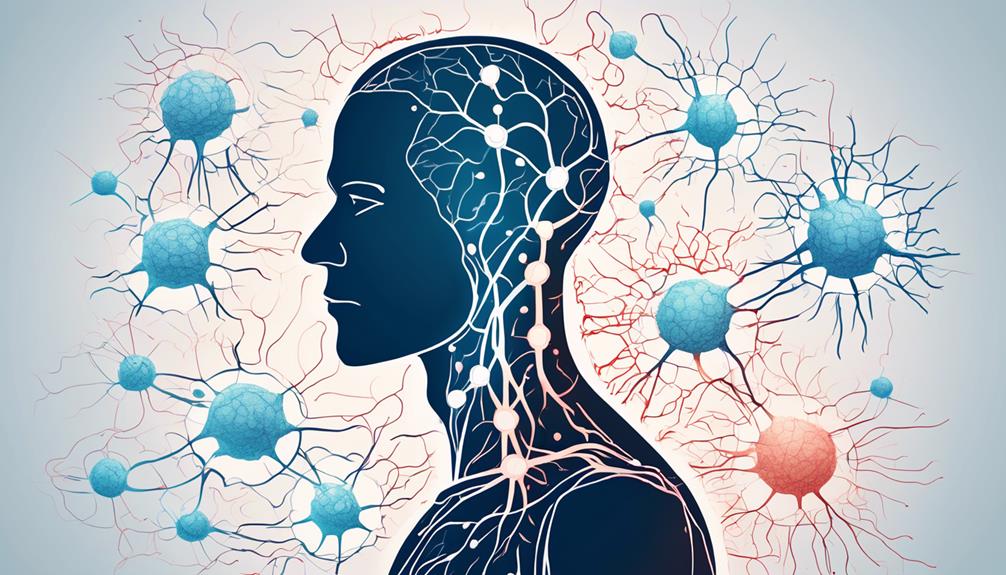Connective Tissue Autoimmune Diseases
Just as you’ve learned to trust your body’s natural defences to keep you healthy, imagine the surprise and confusion when it turns on itself, resulting in a connective tissue autoimmune disease.
You’re not alone if you’re grappling with this perplexing turn of events, where your immune system, the guardian against pathogens, mistakenly attacks your tissues, those vital fibres holding your body together.
As you sit with the diagnosis of conditions like lupus, which can colour your daily experiences with fatigue and joint pain, or vasculitis, which inflames your blood vessels, you’re faced with a complex reality. Understanding these disorders is a crucial step towards regaining control.
So, let’s explore the underlying mechanisms, the therapeutic options available, and the ongoing research that could one day change the way you live with your condition.
Key Takeaways
- Rheumatoid arthritis and systemic lupus erythematosus are examples of autoimmune connective tissue diseases.
- Connective tissue diseases involve the immune system attacking healthy tissues.
- Early recognition of symptoms is crucial for timely intervention.
- Treatment includes medication, physical therapy, and lifestyle changes to manage symptoms and prevent complications.
Understanding Connective Tissue Diseases

While connective tissue diseases vary widely in their symptoms and severity, they all stem from an immune system malfunction that targets the body’s supportive framework.
If you’re seeking to help those affected, it’s crucial to understand these conditions often involve an autoimmune connective tissue disease, where the body mistakenly attacks its tissues. Rheumatoid arthritis and systemic lupus erythematosus are two such diseases that can cause significant discomfort and disability, demanding compassionate care and support.
In managing these conditions, you might encounter mixed connective tissue disease, an overlap of disorders including systemic sclerosis and polymyositis, which complicates diagnosis and treatment plans. Your role in serving patients includes recognizing the signs of scleroderma, with its skin hardening, or dermatomyositis, which affects the skin and muscles.
Understanding the nuances of undifferentiated connective tissue disease, where symptoms don’t match a single disease, is also important in providing thorough care.
Identifying Symptoms and Causes
Understanding that symptoms of connective tissue diseases can widely vary, you may experience issues ranging from joint pain to skin abnormalities, depending on the specific condition and its underlying causes. Recognizing the early signs and symptoms is crucial for timely intervention and support.
Here are some common symptoms and causes you should be aware of:
- Joint Pain and Inflammation: Often an early sign of a connective tissue disease, you might notice swelling, redness, and pain in the joints, which can indicate autoimmune inflammation.
- Skin Changes: Look out for rashes, thickening, or colour changes on the skin, as these could be diagnostic criteria for conditions like scleroderma or dermatomyositis.
- Systemic Issues: Be attentive to symptoms involving internal organs, such as shortness of breath or dryness in the eyes and mouth, which can suggest a broader autoimmune disorder.
If you’re committed to serving others with these conditions, understanding the symptoms and causes is the first step. Autoimmune disorders like these often involve the body’s immune system attacking healthy tissues, leading to a range of signs and symptoms. With the right knowledge, you can better support those affected by connective tissue diseases, advocating for their needs and helping them navigate their journey toward well-being.
Diagnostic Methods and Tests

To accurately diagnose connective tissue autoimmune diseases, doctors typically start with a comprehensive medical evaluation and physical examination. They’ll delve into your medical history and look for signs that might suggest an autoimmune connective tissue disorder. Symptoms may include persistent joint pain, skin rashes, or muscle weakness.
Further diagnostic methods and tests come into play to pinpoint the specific condition. Blood tests are crucial; they can detect the presence of particular antibodies that are often associated with autoimmune rheumatic diseases. For instance, the antinuclear antibody (ANA) test is commonly used, as many autoimmune diseases trigger the body to produce ANAs.
Additionally, the erythrocyte sedimentation rate (ESR) test measures how quickly red blood cells settle at the bottom of a test tube. An elevated ESR indicates inflammation, which is a hallmark of rheumatic disease. Other tests might assess organ function and check for markers of inflammation.
In cases of undifferentiated connective tissue disease or overlap disease, where symptoms may span multiple conditions, a more nuanced approach is needed. Imaging studies like MRI can assess tissue damage, and sometimes a biopsy is warranted to obtain a definitive diagnosis.
These diagnostic steps are essential in tailoring treatment and providing the best care possible for those affected.
Treatment and Management Strategies
Managing connective tissue autoimmune diseases requires a multifaceted approach that typically includes medication, physical therapy, and lifestyle changes to alleviate symptoms and minimize the risk of organ damage.
When you’re helping someone navigate their treatment options, it’s essential to understand that:
- Symptoms may vary and the disease course can be unpredictable, making personalized care paramount.
- The goal is to manage symptoms and prevent complications, such as pulmonary hypertension in systemic autoimmune diseases.
- Regular monitoring and adaptation of treatment strategies are crucial, as the immune system attacks can fluctuate over time.
Medications like corticosteroids are often employed to reduce inflammation and regulate the immune response. However, long-term use of corticosteroids comes with its risks, so it’s important to monitor for side effects and adjust dosages as needed.
Additionally, physical therapy can help maintain mobility and function, while lifestyle modifications, such as stress management and a balanced diet, support overall well-being.
Prognosis and Living With the Condition

While effective management strategies are key for living with connective tissue autoimmune diseases, the long-term outlook or prognosis can vary significantly from person to person. For those of you committed to serving others grappling with these conditions, understanding the variability in prognosis is crucial. W
ith diseases such as systemic lupus erythematosus (SLE) and mixed connective tissue disease (MCTD), symptoms vary widely, and so does the impact on quality of life. Living with the condition means adapting to a life of chronic management, where both physical and emotional support play a pivotal role.
In your journey to aid others, you’ll find that some individuals maintain a fulfilling life despite their diagnosis, while others may face more significant challenges. Below is a table that can help guide your understanding of the factors influencing prognosis:
| Factor Influencing Prognosis | Potential Impact on Quality of Life |
|---|---|
| Disease Severity | Can range from mild to debilitating |
| Treatment Response | May improve or stabilize condition |
| Lifestyle Choices | Positive changes can enhance health |
| Medical Care | Regular monitoring/treatment crucial |
| Complications | Risk of organ damage, joint issues |
Understanding Autoimmune Disorders of the Connective Tissue
What are Autoimmune Connective Tissue Diseases?
Defining Connective Tissue and the Role it Plays
Connective tissue, composed of elements like collagen and blood vessels, provides structure and support for other tissues and organs. It also serves vital roles in the inflammatory and healing processes.
Explanation of Autoimmune Disorders
An autoimmune disorder occurs when the body’s immune system attacks its tissues, leading to inflammation, damage, and dysfunction. In connective tissue diseases, various components like collagen and vasculature are attacked.
How Autoimmune Disorders Affect the Connective Tissue
In connective tissue diseases, the immune system attacks the connecting structures, leading to inflammation, formation of scar tissue, and organ dysfunction. Examples of such conditions include lupus, scleroderma, and mixed connective tissue disease.
Types of Connective Tissue Diseases with Autoimmune Origin
Overview of Undifferentiated Connective Tissue Disease (UCTD)
UCTD represents a category of undifferentiated connective tissue disorders. The disease is characterized by signs and symptoms of connective tissue inflammation but does not meet the diagnostic criteria for a specific systemic autoimmune disease.
Introduction to Mixed Connective Tissue Disease (MCTD)
MCTD is a systemic autoimmune condition, a hybrid of distinct disorders like systemic lupus erythematosus, scleroderma, and polymyositis. The disease may cause symptoms like puffy hands and Raynaud’s phenomenon.
Insights into Systemic Lupus Erythematosus (SLE)
SLE, often referred to as lupus, is a chronic disease characterized by inflammation in various internal organs and the skin. This autoimmune disorder is often marked by a ‘butterfly rash’ on the face.
Distinct Symptoms and Causes of Connective Tissue Diseases
Common Symptoms of Autoimmune Connective Tissue Diseases
Signs and symptoms of connective tissue disorders can vary widely. Symptoms may include fatigue, joint pain or swelling, skin rashes, muscle weakness, and difficulties in swallowing.
Causes and Risk Factors of Connective Tissue Disorders
These diseases often have genetic predispositions and may be triggered by environmental factors. They can cause conditions like Marfan syndrome, polymyositis, and systemic sclerosis.
How the Immune System Attacks Connective Tissue
The immune system, in autoimmune disorders, produces antibodies that attack the body’s own cells, causing inflammation and tissue damage. This process can affect various system organs like the heart, lungs, skin, and joints.
Diagnostic and Treatment Approaches for Connective Tissue Disorders
Diagnostic Process of Autoimmune Connective Tissue Diseases
The diagnostic process for these disorders can be complex and often involves blood tests, imaging studies, and potentially biopsy.
Treatment Options, Including Corticosteroid Therapy
Treatment options for these diseases usually aim to manage symptoms and slow disease progression. Common treatments include corticosteroid therapy, immunosuppressant drugs, and physiotherapy. Early diagnosis and treatment can help manage these conditions better.
The Importance of Early Diagnosis and Treatment
Early diagnosis and treatment can help to manage symptoms and can limit long-term damage. It’s important to monitor for complications such as interstitial lung disease and pulmonary hypertension.
Impact of Connective Tissue Disorders on Quality of Life
Fluctuations in Disease Activity and Their Effects
Fluctuations in disease activity can greatly affect a person’s quality of life. During periods of disease activity, or ‘flares’, symptoms may exacerbate causing discomfort and disruption to daily routines.
Complications and Comorbidities of Connective Tissue Disorders
The autoimmune nature of these diseases can lead to complications in various organs and systems. Comorbid conditions like cardiovascular disease or other autoimmune conditions are not uncommon.
Psychosocial Impact and Strategies for Managing Symptoms
The burden of these diseases extends beyond physical symptoms, impacting mental health, social interactions, and overall quality of life. Active self-care and participation in supportive communities can help individuals cope with the disease’s psychosocial implications.
Frequently Asked Questions
Conclusion
Living with a connective tissue autoimmune disease is indeed challenging, but you’re not alone. By understanding your symptoms and getting the right diagnosis, you can find effective treatments to manage your condition.
Remember, advancements in medicine are ongoing, and there’s always hope for a better quality of life. Stay informed, work closely with your healthcare team, and don’t hesitate to seek support.
Your journey is unique, but it’s one you don’t have to walk by yourself.

